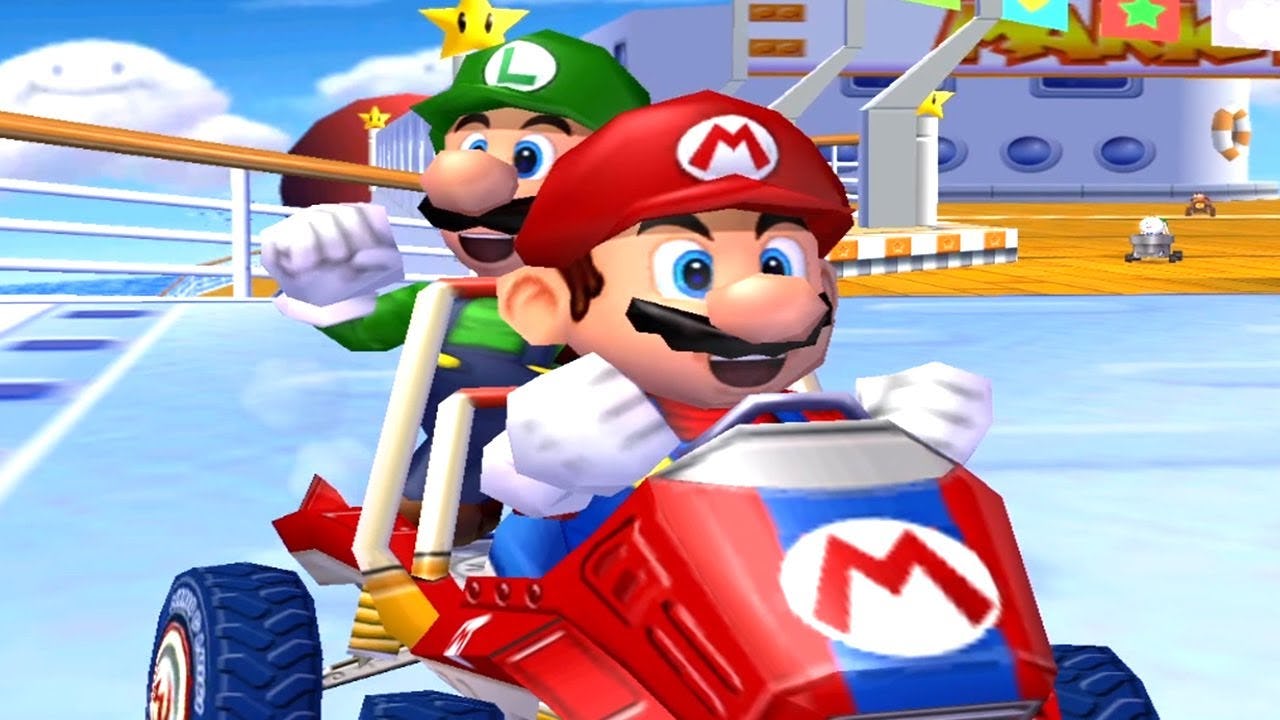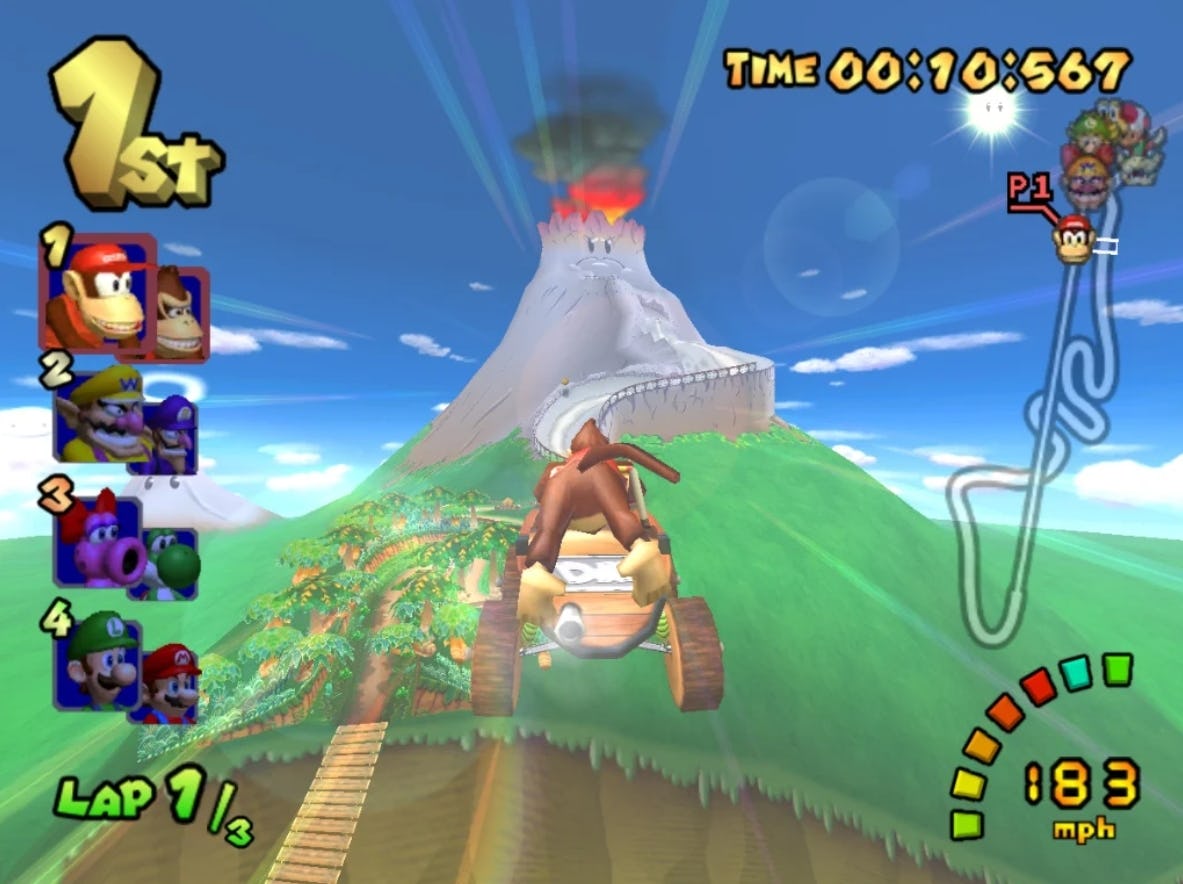
Nintendo, despite its family-friendly reputation, has dug more graves than a serial murderer. We haven’t had a proper Donkey Kong game in nine years. We haven’t had a proper F-Zero game in 20. If you ask a Nintendo employee about the company’s future plans for Labo, they wipe your memory with the Men in Black neuralyzer. Fail to live up to Nintendo’s expectations and you will be entombed within a vault so deep and dark it makes Disney look benevolent.
Chief among the damned is Mario Kart: Double Dash!!, which is both the second best-selling GameCube game of all time and the Mario Kart title most likely to elicit a passionless “Eh” from fans. Mario Kart 64 was a beloved landmark title, the famous franchise’s first foray into 3D. Mario Kart 8 has sustained the series for nearly a decade, adding a steady stream of new tracks and racers while buttressing the library of two consoles. Double Dash!! was… also there, its excessive punctuation just a little too eager to attract your attention.
Double Dash received sterling reviews in 2003, but a few critical outliers made points that have since haunted its reputation. It was gimmicky rather than innovative. It was unfair. It lacked depth and content. The tracks were bland. Most importantly, it hadn’t done enough to improve on its predecessor. Mario Kart 64 was seven years old. Was this all Nintendo had come up with in the interim?

Double Dash is gimmicky, but the gimmick is clever, and it’s a bit surprising that Nintendo has since abandoned it. Instead of one driver, you pick two, and can switch between them with a button press. Whoever’s driving can grab an item, then switch to the backseat with their banana peel or red shell still under their control. In single-player, controlling both racers adds another layer to item management, while in multiplayer, two friends can swap between driver and gunner as they see fit. In both cases, races can be completely turned around when fusillades of items are unleashed in concert.
The item spam (and the lack of defensive options seen elsewhere in the series) tends to make races even more chaotic than usual. Unlike Mario Kart 8, where a talented racer can still go wire to wire despite a few blue shells being hucked at them, sudden reversals of fortune are common. This can be either amusing or infuriating, depending on your perspective, and it’s certainly not the game for showing friends your undisputable prowess or putting your uppity children in their place.
You can still apply your skills, though. Double Dash was notably the first Mario Kart game to make drifting feel natural, rather than like a sluggish attempt to curl a small boulder around an icy sheet of linoleum.
Perhaps that’s also why Double Dash is looked on with some disdain. Drifting felt phenomenal, but later Mario Kart games refined its formula even further. The jump from the passive sprites of Mario Kart 64 to the bouncy 3D models of Double Dash felt like a massive technical leap, but they pale in comparison to the modern polish of Mario Kart 8.
So do the character and track rosters. The waterspouts of Dino Dino Jungle and cannon launch up an unstable volcano in DK Mountain were whimsical and inventive, but it’s hard to be satisfied with 16 tracks when Mario Kart 8 offers a staggering 96.

The title of “best” Mario Kart game arguably belongs to whatever one you grew up with and/or drunkenly played the most in college, but Double Dash rarely threatens to take the crown. It’s a little too weird and a little too messy. It’s the Zelda II of the Kart world. Still, Double Dash is an easy joy to pick up and play… if you can. Unless you’ve been carrying your GameCube around by its handle for the last 22 years, you’re out of luck.
The difficulty of playing beloved GameCube titles is a broader problem, as Nintendo seems content to keep its old classics out of the marketplace so they can be turned into full-priced remasters (Pikmin 1 + 2), mined for content in larger sequels (Super Smash Bros. Melee), or simply consigned to oblivion (that Wind Waker isn’t available on the Switch is a minor crime against humanity). Double Dash is one of this policy’s more high-profile victims.
Maybe that’s a side-effect of the GameCube’s own shrug-worthy reputation, but it’s frustrating to see Nintendo ignore one of its most successful titles. Many of Double Dash’s tracks have made it to Mario Kart 8, but why not put the whole game up on the Switch eShop? Every game has its own feel, and something is lost when companies like Nintendo view their own creations as content to be stripped for parts, rather than as experiences worth preserving and passing down in their own right.
Perhaps, at the very least, a two-character-per-kart option could be included in the inevitable Mario Kart 9 to add an optional strategic wrinkle and probable profanity from players outraged at being the subject of an item bombardment. It would be a fitting tribute to a game that provided countless hours of joy in between Mario’s more famous kart tours.




!["[T]he First and Fifth Amendments Require ICE to Provide Information About the Whereabouts of a Detained Person"](https://images.inkl.com/s3/publisher/cover/212/reason-cover.png?w=600)


